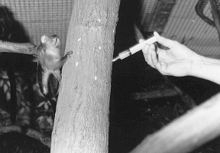- Black-tailed marmoset
-
Black-tailed marmoset[1][2] Black-tailed marmoset at London Zoo Conservation status Scientific classification Kingdom: Animalia Phylum: Chordata Class: Mammalia Order: Primates Suborder: Haplorrhini Family: Callitrichidae Genus: Mico Species: M. melanurus Binomial name Mico melanurus
(É. Geoffroy, 1812)
Black-tailed Marmoset range Synonyms - leucomerus Gray, 1846
- leukeurin Natterer in Pelzeln, 1883
The black-tailed marmoset (Mico melanurus) is a species of New World monkey from central South America, where ranging from the south-central Amazon in Brazil, south through the Pantanal and eastern Bolivia, to the Chaco in far northern Paraguay.[3] It is the southernmost member of the genus Mico and the only where most of its range is outside the Amazon.[4]
The black-tailed marmoset is dark brown with paler foreparts and a black tail. Unlike most of its relatives, it has a striking white or yellow-white stripe that extends down its thigh.[4] Its ears are naked, flesh-colored and stand out from the fur. They reach a size of 18 to 28 cm and weigh from 300 to 400 g.
Black-tailed marmosets are diurnal and arboreal, using their claws to climb trees. Originally rain forest inhabitants, plantations have caused them to expanded them their range. They spend the night in tree hollows or in very close vegetation. They live together in small groups and mark their territory with scent glands, driving out intruders by shouting or by facial expressions (lowered brows and guarded lips).
The diet of the black-tailed marmoset predominantly consists of tree sap. To a lesser extent, they also eat bird eggs, fruits, insects, and small vertebrates.
After a 145 day gestation period, the female bears two (or rarely three) offspring. As is the case for many callitrichines, the father and the other group members take part with the raising of the offspring. Within six months the young are weaned, with full maturity coming at about two years of age.
References
- ^ Groves, C. (2005). Wilson, D. E., & Reeder, D. M, eds. ed. Mammal Species of the World (3rd ed.). Baltimore: Johns Hopkins University Press. pp. 132. OCLC 62265494. ISBN 0-801-88221-4. http://www.bucknell.edu/msw3/browse.asp?id=12100203.
- ^ Rylands AB and Mittermeier RA (2009). "The Diversity of the New World Primates (Platyrrhini)". In Garber PA, Estrada A, Bicca-Marques JC, Heymann EW, Strier KB. South American Primates: Comparative Perspectives in the Study of Bahavior, Ecology, and Conservation. Springer. pp. 23–54. ISBN 978-0-387-78704-6.
- ^ a b Rylands, A. B., Mittermeier, R. A. & Wallace, R. B. (2008). Mico melanurus. In: IUCN 2008. IUCN Red List of Threatened Species. Downloaded on 2 January 2009.
- ^ a b Rylands, Mittermeier, Coimbra-Filho, Heymann, de la Torre, Silva Jr., Kierulff, Noronha and Röhe (2008). Marmosets and Tamarins: Pocket Identification Guide. Conservation International. ISBN 978-1-934151-20-4
Categories:- IUCN Red List least concern species
- Mammals of South America
- Callitrichidae
- Animals described in 1812
Wikimedia Foundation. 2010.



